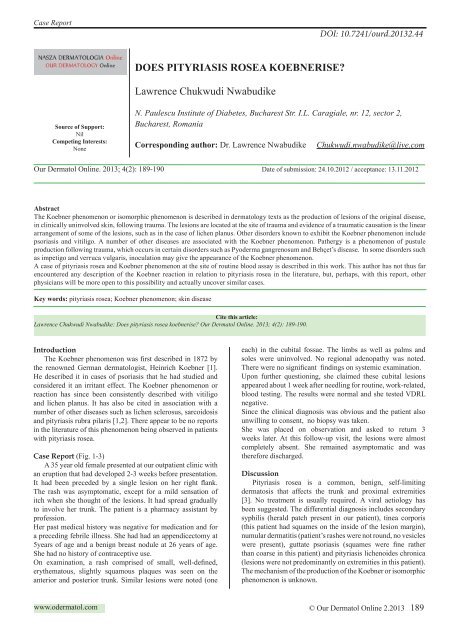download full issue - Our Dermatology Online Journal
download full issue - Our Dermatology Online Journal
download full issue - Our Dermatology Online Journal
Create successful ePaper yourself
Turn your PDF publications into a flip-book with our unique Google optimized e-Paper software.
Case Report<br />
DOI: 10.7241/ourd.20132.44<br />
DOES PITYRIASIS ROSEA KOEBNERISE?<br />
Lawrence Chukwudi Nwabudike<br />
Source of Support:<br />
Nil<br />
Competing Interests:<br />
None<br />
N. Paulescu Institute of Diabetes, Bucharest Str. I.L. Caragiale, nr. 12, sector 2,<br />
Bucharest, Romania<br />
Corresponding author: Dr. Lawrence Nwabudike<br />
Chukwudi.nwabudike@live.com<br />
<strong>Our</strong> Dermatol <strong>Online</strong>. 2013; 4(2): 189-190 Date of submission: 24.10.2012 / acceptance: 13.11.2012<br />
Abstract<br />
The Koebner phenomenon or isomorphic phenomenon is described in dermatology texts as the production of lesions of the original disease,<br />
in clinically uninvolved skin, following trauma. The lesions are located at the site of trauma and evidence of a traumatic causation is the linear<br />
arrangement of some of the lesions, such as in the case of lichen planus. Other disorders known to exhibit the Koebner phenomenon include<br />
psoriasis and vitiligo. A number of other diseases are associated with the Koebner phenomenon. Pathergy is a phenomenon of pustule<br />
production following trauma, which occurs in certain disorders such as Pyoderma gangrenosum and Behçet’s disease. In some disorders such<br />
as impetigo and verruca vulgaris, inoculation may give the appearance of the Koebner phenomenon.<br />
A case of pityriasis rosea and Koebner phenomenon at the site of routine blood assay is described in this work. This author has not thus far<br />
encountered any description of the Koebner reaction in relation to pityriasis rosea in the literature, but, perhaps, with this report, other<br />
physicians will be more open to this possibility and actually uncover similar cases.<br />
Key words: pityriasis rosea; Koebner phenomenon; skin disease<br />
Cite this article:<br />
Lawrence Chukwudi Nwabudike: Does pityriasis rosea koebnerise? <strong>Our</strong> Dermatol <strong>Online</strong>. 2013; 4(2): 189-190.<br />
Introduction<br />
The Koebner phenomenon was first described in 1872 by<br />
the renowned German dermatologist, Heinrich Koebner [1].<br />
He described it in cases of psoriasis that he had studied and<br />
considered it an irritant effect. The Koebner phenomenon or<br />
reaction has since been consistently described with vitiligo<br />
and lichen planus. It has also be cited in association with a<br />
number of other diseases such as lichen sclerosus, sarcoidosis<br />
and pityriasis rubra pilaris [1,2]. There appear to be no reports<br />
in the literature of this phenomenon being observed in patients<br />
with pityriasis rosea.<br />
Case Report (Fig. 1-3)<br />
A 35 year old female presented at our outpatient clinic with<br />
an eruption that had developed 2-3 weeks before presentation.<br />
It had been preceded by a single lesion on her right flank.<br />
The rash was asymptomatic, except for a mild sensation of<br />
itch when she thought of the lesions. It had spread gradually<br />
to involve her trunk. The patient is a pharmacy assistant by<br />
profession.<br />
Her past medical history was negative for medication and for<br />
a preceding febrile illness. She had had an appendicectomy at<br />
5years of age and a benign breast nodule at 26 years of age.<br />
She had no history of contraceptive use.<br />
On examination, a rash comprised of small, well-defined,<br />
erythematous, slightly squamous plaques was seen on the<br />
anterior and posterior trunk. Similar lesions were noted (one<br />
each) in the cubital fossae. The limbs as well as palms and<br />
soles were uninvolved. No regional adenopathy was noted.<br />
There were no significant findings on systemic examination.<br />
Upon further questioning, she claimed these cubital lesions<br />
appeared about 1 week after needling for routine, work-related,<br />
blood testing. The results were normal and she tested VDRL<br />
negative.<br />
Since the clinical diagnosis was obvious and the patient also<br />
unwilling to consent, no biopsy was taken.<br />
She was placed on observation and asked to return 3<br />
weeks later. At this follow-up visit, the lesions were almost<br />
completely absent. She remained asymptomatic and was<br />
therefore discharged.<br />
Discussion<br />
Pityriasis rosea is a common, benign, self-limiting<br />
dermatosis that affects the trunk and proximal extremities<br />
[3]. No treatment is usually required. A viral aetiology has<br />
been suggested. The differential diagnosis includes secondary<br />
syphilis (herald patch present in our patient), tinea corporis<br />
(this patient had squames on the inside of the lesion margin),<br />
numular dermatitis (patient’s rashes were not round, no vesicles<br />
were present), guttate psoriasis (squames were fine rather<br />
than coarse in this patient) and pityriasis lichenoides chronica<br />
(lesions were not predominantly on extremities in this patient).<br />
The mechanism of the production of the Koebner or isomorphic<br />
phenomenon is unknown.<br />
www.odermatol.com<br />
© <strong>Our</strong> Dermatol <strong>Online</strong> 2.2013 189















